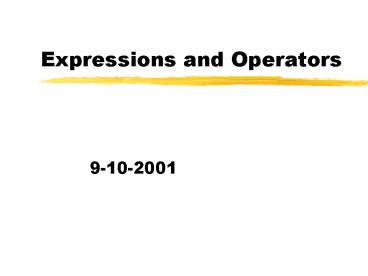Expressions and Operators PowerPoint PPT Presentation
Title: Expressions and Operators
1
Expressions and Operators
- 9-10-2001
2
Opening Discussion
- What did we talk about last class?
- Working in Linux out of class time. This room is
open quite a bit of the time. I would be more
than happy to have a session working on Linux
and vi with people in here some afternoon. - What is a variable?
3
Variables
- A variable in a programming language is nothing
more than a place to store a value. Think of it
as a box if you want. - Variables in programming languages are similar to
those in algebra, but they differ in very
significant ways. Because of this you can put
things in a program that would make no sense in
algebra. - nn1
4
Declarations
- In the C programming language, all entities
must be declared before they are used. This is
true for variables as well as other entities like
functions and classes that we will discuss later. - A variable declaration is simply a statement with
a type and a name. Optionally it can also give
it a default value. Well talk more about types
later today.
5
Assignments
- The way you store something in a variable is
through an assignment. - In C an assignment is denoted with an equal
sign. What this actually indicates is that the
value of the expression on the right side
(rvalue) should be stored in the memory location
of the variable on the left side (lvalue). - Later we will talk about tests for equality.
6
Numeric Expressions
- Perhaps the most straightforward type of
expressions in C are numeric expressions.
These look very much like normal math formulae
but you have to be a bit more rigid with how
things are entered. - Simple expressions can be literals (5, 2.9, etc.)
or variables. Complex expressions can be formed
by joining expressions with numeric operators.
7
Numeric Operators
- C has a fair number of numeric operators.
- Common two argument operators (, -, , /)
- Common one argument operator (-)
- Less common two argument operators
- - remainder (or modulo)
- - bitwise and
- - bitwise or
- - bitwise xor (NOT exponent)
- ltlt and gtgt - left-shift and right-shift
- Unary bitwise negation (), not even in book.
8
Order of Operation
- For most of the normal operators the precedence
is the same as in normal arithmetic (PEMDAS).
You book lists the precedence of most all of the
C operators in appendix C. - It is generally recommended that you use
parenthesis to make it clear how things are to be
evaluated in an expression if there is any
possible reason to question.
9
Types in C
- A very significant feature of any programming
language is its typing system. Type here does
not relate to a keyboard, but instead to
categories of how the computer interprets what is
stored at different memory locations. - In C the type of a variable or object is very
important as it determines what you can do with
the object. For this class we will only use the
strengths of the C typing system and not focus
on the holes is has left over from C.
10
Integer Types
- There are a number of primitive types in C.
One collection of these are the integer types.
These are types that represent whole number
values. - int - This is what you will generally use.
- short
- long
- char - used to represent characters too.
- Exact size of all depends on hardware and
implementation. All can be modified with
unsigned.
11
Floating Point Types
- When you want to represent a number that has a
fractional part you use a floating point type - float - standard precision floating point number.
- double - double precision floating point number.
This is what you will use most of the time. - These numbers are stored in computers much like
scientific notation.
12
Polymorphism, Overloading, and Type Conversion
- In C the basic numeric operators work on both
integers and floating point values. When a piece
of code works with multiple types it is called
polymorphism. In this case the polymorphism is
created by overloading, one of the weakest forms
of polymorphism. - C also does implicit type conversions on
numbers when types are mixed. It converts to the
type that typically doesnt lose information. - 13.7 4 is a double plus an int. When evaluated
it has the type double. Same for 13.0 4.
13
The string Type
- Another type that I used in the example code on
Friday was the strong type. The numeric types
just discussed are primitive types. They are
typically built into the hardware I some way.
They arent really objects. Their only
attribute is their value and they have no
behaviors. A string is a true object (an
instantiation of a class). It allows you to
store sequences of characters. - Strings can be concatenated with , another
instance of overloading.
14
Minute Essay
- Numerical expressions in C are quite similar to
those you are used to from algebra with a few
differences. Those differences though are
significant and can cause problems with your
comprehension of this topic. Do you feel
comfortable with this now? Could you write a
simple program that performs numerical operation
on paper?

